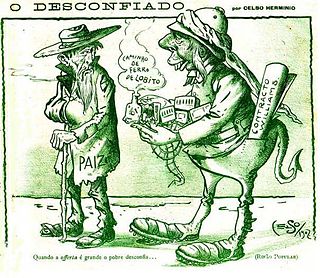
Luanda is the capital and largest city of Angola. It is Angola's primary port, and its major industrial, cultural and urban centre. Located on Angola's northern Atlantic coast, Luanda is Angola's administrative centre, its chief seaport, and also the capital of the Luanda Province. Luanda and its metropolitan area is the most populous Portuguese-speaking capital city in the world and the most populous Lusophone city outside Brazil. In 2020 the population reached more than 8.3 million inhabitants.

Bié is a province of Angola located on the Bié Plateau in central part of country. Its capital is Kuito, which was called Silva Porto until independence from Portugal in 1975. The province has an area of 70,314 square kilometres (27,148 sq mi) and a population of 1,455,255 in 2014. The current governor of Bié is José Amaro Tati.

Malanje is a province of Angola. It has an area of 97,602 km2 and a 2014 census population of 986,363. Malanje is the provincial capital.

Moçâmedes is a city in southwestern Angola, capital of Namibe Province. The city's current population is 255,000. Founded in 1840 by the Portuguese colonial administration, the city was named Namibe between 1985 and 2016. Moçâmedes has a cool dry climate and desert vegetation, because it is near the Namib Desert.

Uíge is one of the eighteen Provinces of Angola, located in the northwestern part of the country. Its capital city is of the same name.

Lubango, formerly known as Sá da Bandeira, is a municipality in Angola, capital of the Huíla Province, with a population of 914,456 in 2022. The city center had a population of 600,751 in 2014 making it the second-most populous city in Angola after the capital city Luanda.

Benguela is a city in western Angola, capital of Benguela Province. Benguela is one of Angola's most populous cities with a population of 555,124 in the city and 561,775 in the municipality, at the 2014 census.
Caconda is a town and a municipality in the province of Huíla, Angola. The municipality had a population of 167,820 in 2014.

The Ovimbundu, also known as the Southern Mbundu, are a Bantu ethnic group who live on the Bié Plateau of central Angola and in the coastal strip west of these highlands. As the largest ethnic group in Angola, they make up 38 percent of the country's population. Overwhelmingly the Ovimbundu follow Christianity, mainly the Igreja Evangélica Congregacional de Angola (IECA), founded by American missionaries, and the Catholic Church. However, some still retain beliefs and practices from African traditional religions.

Cuíto, formerly known as Silva Porto, is a city and municipality in central Angola, capital of Bié Province. The municipality had a population of 450,881 in 2014. Projected to be the tenth fastest growing city on the African continent between 2020 and 2025, with a 5.56% growth.

N'dalatando, formerly Vila Salazar, is a town, with a population of 161,584 (2014), and a commune in the municipality of Cazengo, province of Cuanza Norte, Angola.
Ondjiva, formerly Vila Pereira d'Eça, is a town, with a population of 121,537 (2014), and a commune in the municipality of Cuanhama, province of Cunene, Angola. It is also the administrative capital of Cunene Province and is located at the extreme south of the country, about 42 kilometres (26 mi) from the border with Namibia. It was traditionally the seat of the Ovambo king of the Oukwanyama tribe. Ondjiva was greatly affected by the Angolan Civil War (1975-2002).

The giant sable antelope, also known in Portuguese as the palanca negra gigante, is a large, rare subspecies of the sable antelope native and endemic to the central highlands of Angola, occurring specifically in two areas: Cangandala National Park and Luando Natural Strict Reserve.

Rail transport in Angola consists of three separate Cape gauge lines that do not connect: the northern Luanda Railway, the central Benguela Railway, and the southern Moçâmedes Railway. The lines each connect the Atlantic coast to the interior of the country. A fourth system once linked Gunza and Gabala but is no longer operational.

The Luanda Railway is a 424 km (263 mi) single-track Cape gauge railway line from the Angolan capital of Luanda to Malanje. A branch line departs the railway at Zenza do Itombe for Dondo. The line is operated by the state owned company Caminho de Ferro de Luanda E.P., short CFL EP.

Angola is a potentially rich agricultural country, with fertile soils, a favourable climate, and about 57.4 million ha of agricultural land, including more than 5.0 million ha of arable land. Before independence from Portugal in 1975, Angola had a flourishing tradition of family-based farming and was self-sufficient in all major food crops except wheat. The country exported coffee and maize, as well as crops such as sisal, bananas, tobacco and cassava. By the 1990s Angola produced less than 1% the volume of coffee it had produced in the early 1970s, while production of cotton, tobacco and sugar cane had ceased almost entirely. Poor global market prices and lack of investment have severely limited the sector since independence.

In southwestern Africa, Portuguese Angola was a historical colony of the Portuguese Empire (1575–1951), the overseas province Portuguese West Africa of Estado Novo Portugal (1951–1972), and the State of Angola of the Portuguese Empire (1972–1975). It became the independent People's Republic of Angola in 1975.
Cangandala is a town and municipality in the province of Malanje (Malange) in Angola. It covers an area of 5,770 square kilometres (2,230 sq mi) and its population is 45,120.

The history of rail transport in Angola began during the nineteenth century, when Angola was a colony of Portugal. It has involved the construction, operation and destruction of four separate, unconnected, coast-to-inland systems, in two different gauges. Operations on three of those systems have been largely restored; the other system has been closed.


















